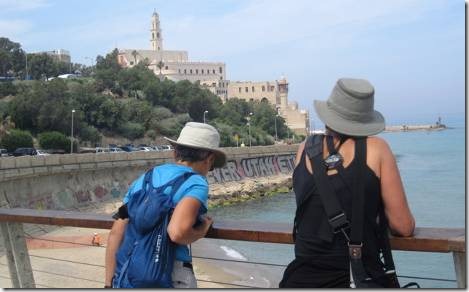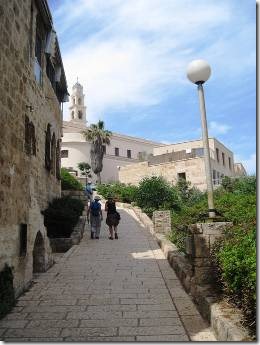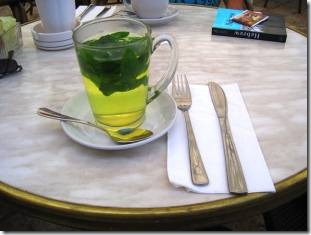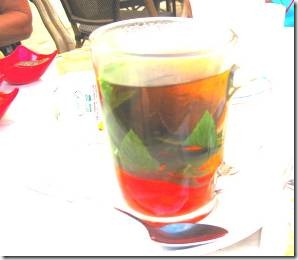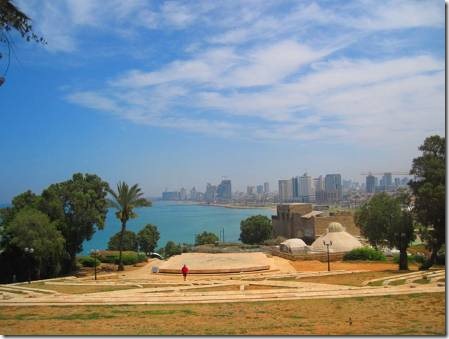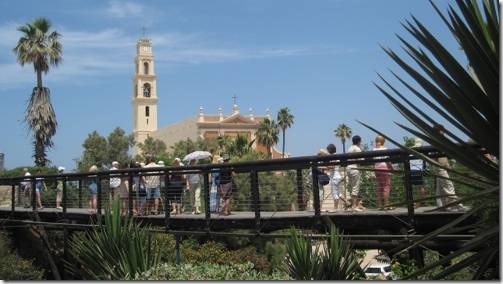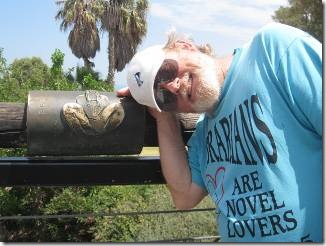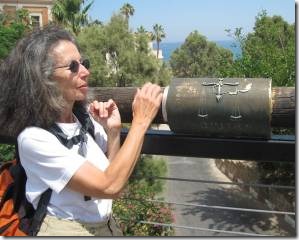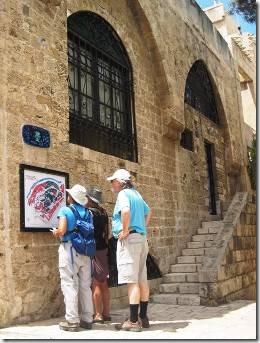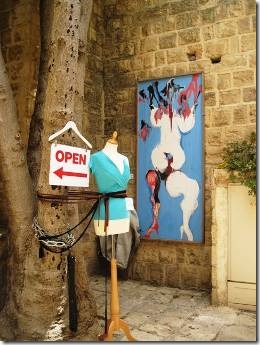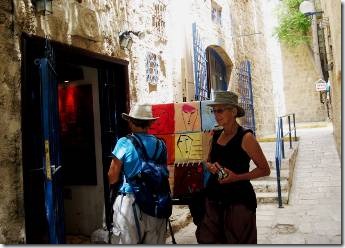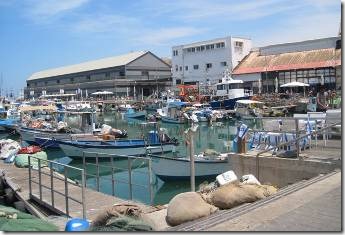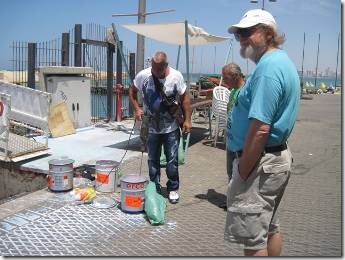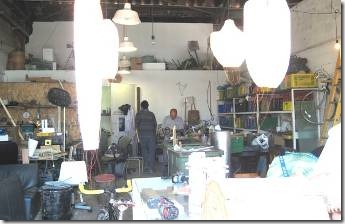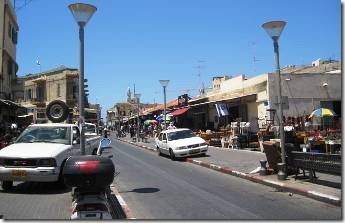Shalom,
Today we met many Israelis. This morning we went to the weekly meeting of the English Speakers Club of Ashdod held at Cafe Hillel in the City Mall. We were welcomed and included and we’ll go back next Friday. This evening Randal and I went to the Friday afternoon/evening meeting of the "Old Salts" on a boat just down the dock from us. We’d sort of met one of the men the day we arrived. He and another man came on board for my 10 minute tour. All of the men work in the marine industry and have for years. All have stories to tell. Randal went first while I was on Eve’s boat helping her with a computer task. Later, I went to retrieve Randal, and ended up staying another hour myself. Two seconds after I’d joined the Old Salts group, I had a glass of beer (I’d asked for water, but the choices were beer, vodka or whiskey,) a wonderful whole small white panfried fish, some great white cheese, pickles, later a pancake with honey, and thick Israeli coffee. So much for just going to get Randal! Randal had tried to have Charmaine and Linda go with him when he left, but they took a pass. When I went off, I thought I’d be back in no time with Randal in tow. By the time Randal and I finally returned to the boat, Charmaine and Linda had made our planned spaghetti dinner! Luckily we returned before the pasta was cooked so they could halve the amount.
Tomorrow we there is a beach fair and later some Israeli folk dancing. We’ll probably go for all or part of it. In the morning I think I may finally check out the Ashdod Art Museum.
This email is a much more light-hearted email than the few previous ones. It’s about our day in Jaffa.
Ru
Jaffa
Shortly after our arrival in Herzliya we took the # 90 bus to the end of its route in south Tel Aviv, just short of Jaffa. We walked the promenade along the beach and climbed the hill into Old Jaffa.
Linda and Charmaine looking towards Old Jaffa Port.
Art or graffiti? Some faces were familiar and some were not.
As Linda Levy said, “if you wanna see something, you gotta go up.”
Jaffa Hill rises 40 meters (130 ft) above sea level.
We went to the visitor center for some maps and then “time for food.”
Mint tea
You get a mug of hot water with lots of mint leaves and a Wissotzky tea bag.
We shared a giant foccacia with some dip and while everyone else had cappuccino, I had a cup of mint tea. I love that they give you Wissotzky tea. My mother used to talk about Wissotzky tea and it is way WAY better than the Lipton they give you every place else.
Looking back towards the Tel Aviv skyline from Jaffa Hill.
I think it’s funny that Tel Aviv was started to get away from crowded Jaffa!
Wishing Bridge
A wooden bridge strung across a narrow road passing through the park is known as the ‘wishing bridge.’ A sign tells us that an ancient legend holds that if one stands on the bridge holding one’s zodiac sign and makes a wish while gazing out to sea, the wish will come true. Whether this is a tale of an old Jaffa fisherman’s wife or not is anybody’s guess, but as a photographic vantage point, one cannot go wrong.
http://www.jpost.com/IsraelGuide/TelAvivAndCenterTours/Article.aspx?id=463
Scorpio Randal and Libra me. Notice neither one of us is touching our symbol or looking to the sea!
We walked through the old section of Jaffa popping into the small arty shops.
I stopped to peer into a window of one of the shops on a street of old stone buildings. There were, what looked like 3 dimensional scenes of people painted on glass of old Jerusalem. A woman came out from the shop. Born in New Jersey, but an Israeli now for many years, her father made the wonderful prints on glass. We talked for a bit and she told me a funny story. She returned to New Jersey to visit her cousin. Remembering the slang of her youth she kept using the phrase, “far out.” Her cousin kept having to say, “no one says that any more.” Funny what changes.
Next we walked over to the small Jaffa port which is developing into a center for design studios.
The small fishing boats.
Randal had to watch these men mix some bondo for a repair job they were doing.
I had to visit this design studio because it just totally reminded me of my nephew Andrew and his design school years.
The we walked through the Jaffa Flea Market area which was lots of fun. But nobody bought nothing.
“The Jaffa Flea Market, or, in Hebrew Shuk Hapishpishim is one of the highlights of the area with vendors selling products of any variety imaginable lining the sidewalks. Weaving your way through an array of treasure, junk, and daily basics, you’ll see everything from Judaica, Persian tiles, jewelry, old jeans, and Indian mildewed clothes. Its an incredible cultural experience, where bargaining and haggling rule the day… fun in itself.” http://www.touristisrael.com/shuk-hapishpishim-jaffa-flea-market/1577/#
Oddly, it was the only day we ever visited Jaffa. Fridays and Saturdays were out because of the shortened day of public transportation on Friday and none on Saturday. When we could travel we went further afield.
Here is some info about Jaffa from the Tel Aviv government website.
History
The story of Jaffa (known in Hebrew and Yafo) begins in the days of ancient Egypt and continues over the generations through the biblical period, the Crusades, the period of the Ottoman Empire and the British Mandate, the War of Independence and the establishment of the State of Israel.
Jaffa’s story begins 4,000 years ago. Archeologists estimate that the Phoenicians, the ancient tribe of sea dwellers, established a city and port by the Jaffa Harbor. It is assumed that the name Jaffa is derived from the word Yafa ("the beautiful") in Arabic and Hebrew. Others attribute it to Japheth, son of Noah, who built it after the flood, and whose name today graces the city’s main street. Jaffa is mentioned in the Book of Jonah, which tells the story of how the Jonah the Prophet descended to the city’s port and sailed for Tarshish in an effort to escape from God’s command.
Another story associated with the city comes from Greek mythology. Many claim that the tale of the beautiful princess Andromeda, who was bound to rocks in the sea, took place exactly facing the shores of Jaffa. Andromeda’s mother, Queen Cassiopeia, bragged that her daughter was more beautiful than the daughters of Poseidon. The Greek god of the sea became angry, inundated the shores of the Land of Israel with tidal waves and sent monsters to devour the people. Cassiopeia was asked to sacrifice her daughter Andromeda to one of the monsters in order to calm his anger. When she bound her to the rocks Perseus killed the monster, thus rescuing and marrying Andromeda. To this day it is possible to catch a glimpse of the chains on Andromeda Rock, at the entrance to the Jaffa Port.
Kings, Emperors and Warriors
Recorded history documents Jaffa as early as the 15th century BCE, when Pharaoh III conquered it and made it his governing center for the region. In biblical times Jaffa was awarded to the Tribe of Dan and, in the days of King Solomon, it served as a major port through which the cedars of Lebanon, which were used to build the holy temple, were imported. It was also through Jaffa that Alexander the Great arrived to conquer the region, as well as a site conquered by the Roman Legions as they went about expanding the borders of the Roman Empire. Centuries later, Jaffa witnessed King Richard the Lion Heart of England as he led a Crusade to fight the armies of Salah-al-Din, and French Emperor Napoleon Bonaparte as he sought to capture the Holy Land from the Ottoman Empire. And all that time, Jaffa served as the main gateway for Christian, Muslim and Jewish pilgrims arriving at the Holy Land.
In 1879 the wall which encircled the old city was breached in order to allow Jaffa to expand. Among the first new quarters to be established was the Hebrew neighborhood of Neve Tzedek, in 1887.
The Struggle for Independence
At the outbreak of World War I, the residents of Tel Aviv found themselves in a state of distress. The Ottomans, who then ruled the land, feared that Tel Aviv would become a base for espionage and subversion against the regime and stopped all development and construction activity in the city. When the British army took over Jaffa by the end of the war, construction was resumed.
From its founding as a neighborhood of Jaffa, Meir Dizengoff, Tel Aviv’s first mayor, struggled to achieve an independent status for his city. During the Arabs riots of 1921 the British granted him his wish and declared Tel Aviv a township. Relations between Jaffa and Tel Aviv were hostile at that time, and they worsened as the Jewish foothold in the country strengthened.
In 1948, as Jewish and Arab forces clashed throughout the country, the members of one of the Jewish underground organizations, the National Military Organization (I.Z.L or "Irgun") set out to conquer Jaffa. Members of the organization tried to take control of Manshia neighborhood, but they were driven back and suffered many casualties On May 13, 1948, Jaffa surrendered a day before the establishment of the State of Israel. A year later Tel Aviv’s new Mayor, Israel Rokach, decided to unite Tel Aviv and Jaffa and, in October 1949, the Government of Israel approved their unification under one municipal authority – the Tel Aviv-Yafo Municipality.
Jaffa Today
Jaffa’s area covers some 6.45 sq kms, which amounts to about 12% of the total area of Tel Aviv – Yafo. Its population, numbering some 45,000 residents, includes Jews and Arabs, Muslims and Christians.
Mayor Ron Huldai has initiated a policy of granting priority and concentrating efforts on the rehabilitation and development of Jaffa. In May 1999 a special unit, Ha-Mishlama Le-Yafo, was established as the executive arm of the municipality for achieving this goal. The Mishlama works to further both building and social projects, and recruiting human and financial resources from the government, the public, the business community and the municipality…..
Jaffa Port
The Tel Aviv – Yafo Municipality purchased Jaffa Port, which for thousands of years had served as a major gateway for the import and export of merchandise to the Land of Israel and as a home base for the Mediterranean fishing boats. Following extensive renovations, the Port is now one of Jaffa’s major entertainment and leisure complexes, with a vibrant and bustling shopping and cultural scene.
Culture and the Arts
Jaffa today is a major cultural hub. With its unique urban scenery and buildings and its proximity to the center of Tel Aviv, Jaffa hosts many youthful, daring and avant-garde artists. Among the many cultural venues in town are Gesher Theatre, the Simta fringe theatre, The Arabic-Hebrew Theatre, and many more.
Jaffa Slope
A unique park, located by the shore of the Mediterranean, is one of the largest recycling projects in Israel. 1.3 million tons of garbage were removed from a 200 dunam (50 acre), 50-foot high garbage mountain and reused to build the park http://www.tel-aviv.gov.il/english/Yafo.htm

